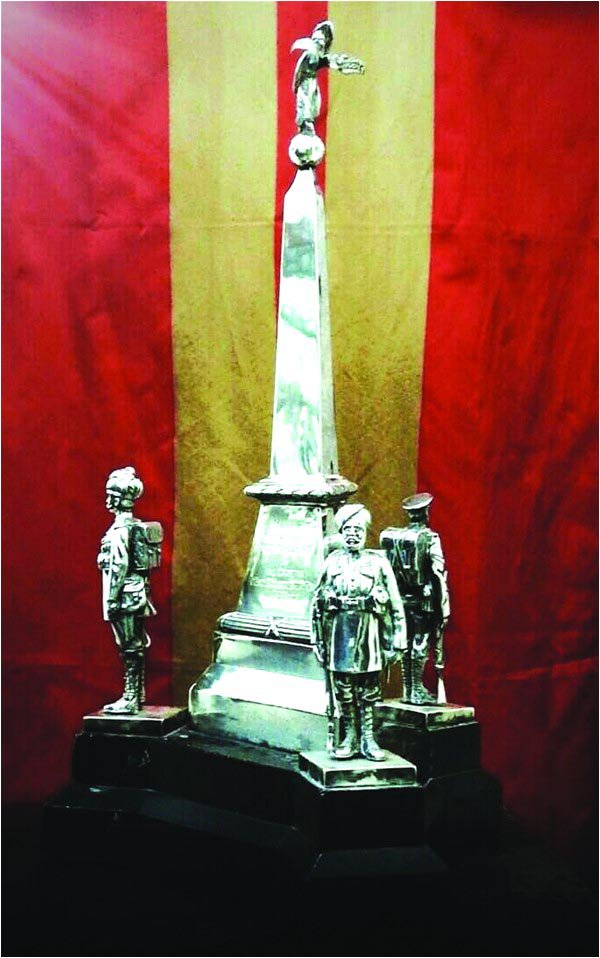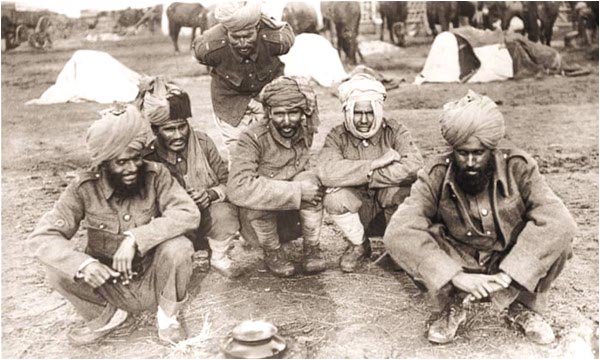A Forgotten Army and Flanders Fields
By Ahmed Jan
The Friday Times : 11 Jan 2019
Ahmed Jan on the soldiers from the Indian Subcontinent who endured the horrors of the First World War and how they are commemorated

A sea of red poppies - remembering the fallen soldiers in 2014
The red poppy is a familiar symbol of Remembrance Day owing to the poem In Flanders Fields, as a reference to the First World War and its battlefields on both sides of the Belgian provinceofFlanders.These poppies bloomed across the worst battlefields of Flanders in the Great War; their deep red colour an appropriate symbol for the spilt blood.
Armistice Day commemorates the end of WW I every year. The remembrance recalls the soldiers who fought for a cause only known to them. The men of British India who fought the Great War deserve to be remembered significantly on this day – alongside those of other nations. However, time has unpleasantly forgotten their sacrifices and has lost them in history.

A woman pins flowers onto the tunics of Indian troops as they march by her
In 2018, the world commemorated the centenary to the end of WWI on Armistice Day. In the years up till then, events were organised to honour the soldiers of the past. At one such unique ceremony in 2014, at the Tower of London– an iconic landmark – every evening a bugler sounded the Last Post at sunset, followed by names being read out from the Roll of Honour.These names and their regiments echoed poignantly. It was noticeable that many of these names were not indigenous to Europe and were only native to the Subcontinent. Those resonating names reminded the audience that the British Indian Army had a prominent role on the Western Front.
The tower’s lush green moat had beenfilled with 888,246 ceramic poppies. The remembrance display was called ‘Blood Swept Lands and Seas of Red’. Every flower represented a fallen soldier – and that included 74,187 soldiers from the Indian Subcontinent, which is now Pakistan, India and Bangladesh.

To commemorate their association, identical silver trophies were made – depicting a soldier each from 59 Scinde, 47 Sikhs and 1st Manchester – which, to this day, are in possession of these three battalions
The Pakistan Army’s history goes far back beyond independence. Several regiments uphold their traditions with pride to this day, having fought the Great War
The British Indian Army’s regimental structure was based on tribes, castes and religious composition. And the Subcontinent provided many men, indeed, for the mass mutual slaughter of the Great War. At the start of the war, the British Indian Army comprised of 28,000 ‘Pathans’ from the North West, 136,000 Punjabi Muslims, 88,000 Sikhs from Punjab, 36,000 Hindustani Muslims from the South of Sutlej River and 23,000 Dogras. The Gurkhas, Rajputs, Jats and Ahirs also contributed in great numbers.The Punjabi Muslimswere the largest single ethnic class to fill the ranks of the British Indian Army.
The War could be argued to be a senseless conflict in the name of ‘King and Country’, which resulted in the meaningless deaths of ordinary Indian men in a foreign land. Such a feeling is not very dissimilar to the view of many British people. Amy Beechey, an Englishwoman from the Lincolnshire countryside, lost five sons to the war. After the Armistice, the woman was presented to King George V and Queen Mary. When the Queen commended her sacrifice, she replied disowning the praise, “It was no sacrifice, Ma’am. I did not give them willingly.”

In the trenches, for the Empire
The Great War would have appeared unjust for an ordinary Briton who was ignorant of the politics of the Balkans. Due to the complexity of treaties and the intricate alliances of Britain, they were drawn into the conflict of empires, but at the lowest tier.
For their part, the men from British India fought for their beliefs of honour and pride. They upheld some of the best traditions of soldiering – and defeated the Imperial German Army in their own backyard. These loyal soldiers of the Subcontinent fought together – varying in colour, ethnicity and religion but spilling the same red blood on Flanders Fields.

Clock Tower – Peshawar
The first native soldier to be a recipient of the most prestigious gallantry award, the Victoria Cross, was from the village Dub in Chakwal District: SepoyKhudadad Khan of 129th Duke of Connaught’s Own Baluchis. His comrades perished and having been wounded himself, he fought through the night and held on to his machine-gun, preventing the German advance at the Battle of Ypres. Similarly, another recipient of the Victoria Cross was Subedar Mir Dast, who hailed from the suburbs of Peshawar’s Maidan valley of Tirah. He joined 55th Coke’s Rifles, Frontier Force, and won his honour while serving with 57th Wilde’s Rifles, Frontier Force. All three battalions at present belong to the Pakistan Army.
The Pakistan Army’s history goes far back beyond independence. Several regiments uphold their traditions with pride to this day, having fought the Great War; the 59th Scinde Rifles, Frontier Force, was one of them. The regiment’s companies and platoons were made up of Punjabi Muslims, Sikhs, Dogras and ‘Pathans’ from the North-West comprising the Bangash, Khattak and Yousafzai tribes.
Despite their ill health, every soldier carried 60 pounds in weight
The 59 Scinde along with 47 Sikhs and 1st Manchester were part of the 8th Jullundur Brigade of the 3rd Lahore Division, which was amongst the very first to set foot on French soil. On the 8th of August 1914, orders were received for mobilisation and all ranks were recalled from leave. It was the soldiers’ sheer esprit de corps that made them return willingly without receiving any official intimation. The regiment embarked at Karachi on HMT Takada to sail to Port Tewfik in Egypt. The soldiers took a rail journey to Alexandria, where they again embarked on a voyage to Marseille, France. The troops received a great ovation by the French and flowers were strewed upon them. After four days the regiment entrained to Orleans. Here several aeroplanes were flying about and this was the first occasion on which the Regiment had a good view of them!
Rearmed with new high-velocity Enfield rifles in France, the 59th, unaccustomed to harsh European weather – was sent to the cold and damp trenches on the 21st of October 1914. The Lahore Division never had their own integral artillery and took the brunt of heavy German bombardment. Neuve Chapelle in France in March 1915 saw the Regiment fight its fierce battle and suffer severe losses of 75 casualties in just one day with more to follow later. In the battle, all British officers were either killed or wounded and the battalion was left to be commanded by a native, Subedar-Major Parbat Chand, by caste a Katoch. He stood his ground and the battalion defended the front until officers were sent to the battalion. Parbat Chand was also awarded the Military Cross. This is a unique honour that the battalion has, to this day, ceremoniously commemorated on the 10th of March every year.

(Top) Names from the Roll of Honour, (Bottom) The Chattri War Memorial,Brighton, a cremation ground for Sikh and Hindu soldiers
The 40th Pathans. The Germans shelled with all the artillery that was available. An 11-inch howitzer shell landed on the Pathans and accounted for 25 men losing their lives, along with transport mules. The march continued on the road, strewn by dead horses, and eventually the regiment under heavy shelling reached its destination. By midday, the 59th with its brigade was poised for a day attack. The soldiers lined up in a disciplined calm manner for an infantry charge. The advance was on a grassy ridge well defended by deadly accurate German machine guns, rifles and artillery fire. It was also the first time that the battalion experienced poison gas shells. The attack was unsuccessful and the men were ordered to fall back to the trenches to prepare and defend against possible enemy counterattacks. After darkness, the wounded and gassed crawled back to their trenches, and stretcher-bearers carried back the wounded and dead to the rear.
59th Scinde Rifles, among many gallantry awards, earned its first posthumous Victoria Cross in the Great War. However, there are dozens of cases where valour was not acknowledged by a medal. Once, a Khattak patrol was fired upon, wounding Sepoy Abdullah Khan in three places. His groans attracted enemy fire. Lance-Naik Biaz Gul and Sepoy Zarif Khan immediately went to save him under heavy fire. The poor soul was rescued, but died soon after.
Each life and death is a story that deserves to be told, remembered and honoured.
Note: An account of the 59th Scinde Rifles is taken from the Regimental History of the 6th Royal Battalion (Scinde) 13th Frontier Forces Rifles, 1843-1934, published in 1935. The battalion above is now 1st Battalion (Scinde) in the Frontier Force Regiment of Pakistan Army and recipient of two Victoria Crosses in both the World Wars.
Along with 59th Scinde Rifles, part of 8th Jullundur Brigade in the Great War, 47 Sikhs is now 5th Battalion, 11th Sikh Regiment of the Indian Army and1st Battalion The Manchester Regiment amalgamated to become King’s Regiment and at present is 2nd Battalion The Duke of Lancaster’s Regiment of the British Army.
Other battalions mentioned: 40th Pathans, 129th Duke of Connaught’s Own Baluchis, 55th Coke’s Rifles, Frontier Force and 57th Wilde’s Rifles, Frontier Force. All continue to exist in Pakistan Army as 16th Battalion The Punjab Regiment, 11th Battalion The Baloch Regiment, 7th Battalion (Coke’s) The Frontier rce Regiment and 9th Battalion (Wilde’s) The Frontier Force Regiment respectively.